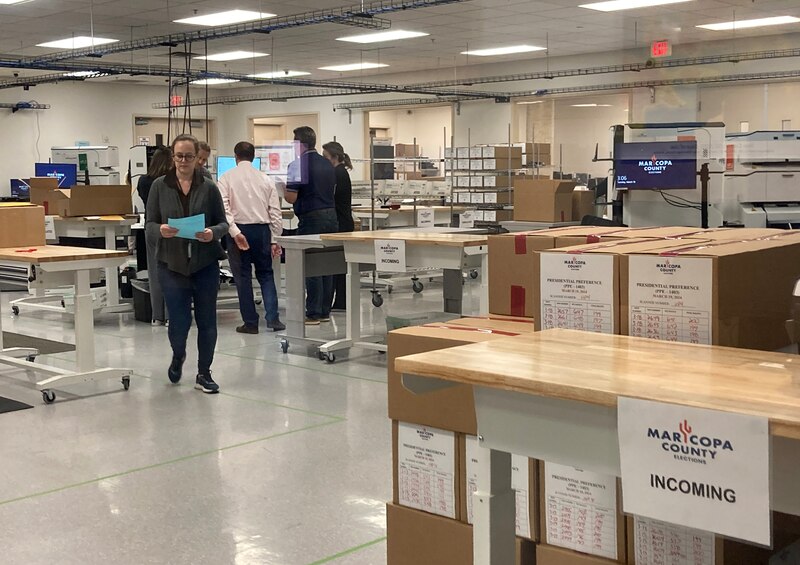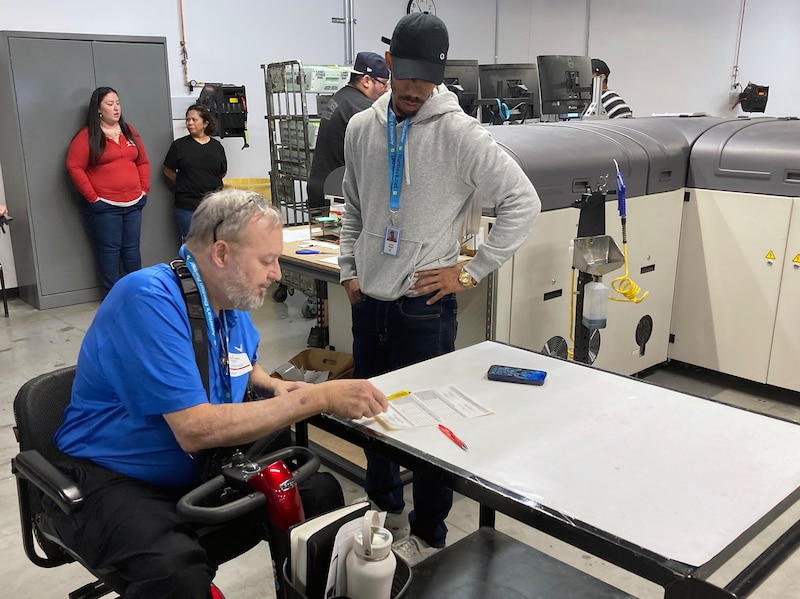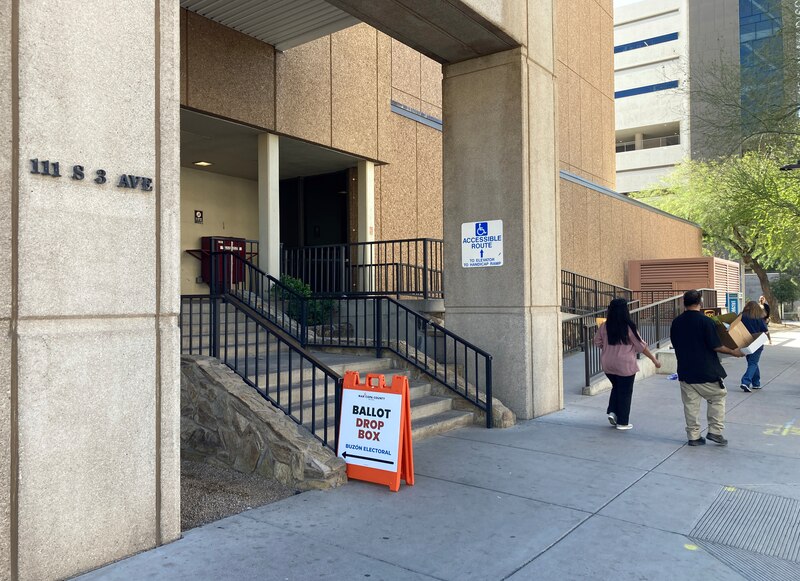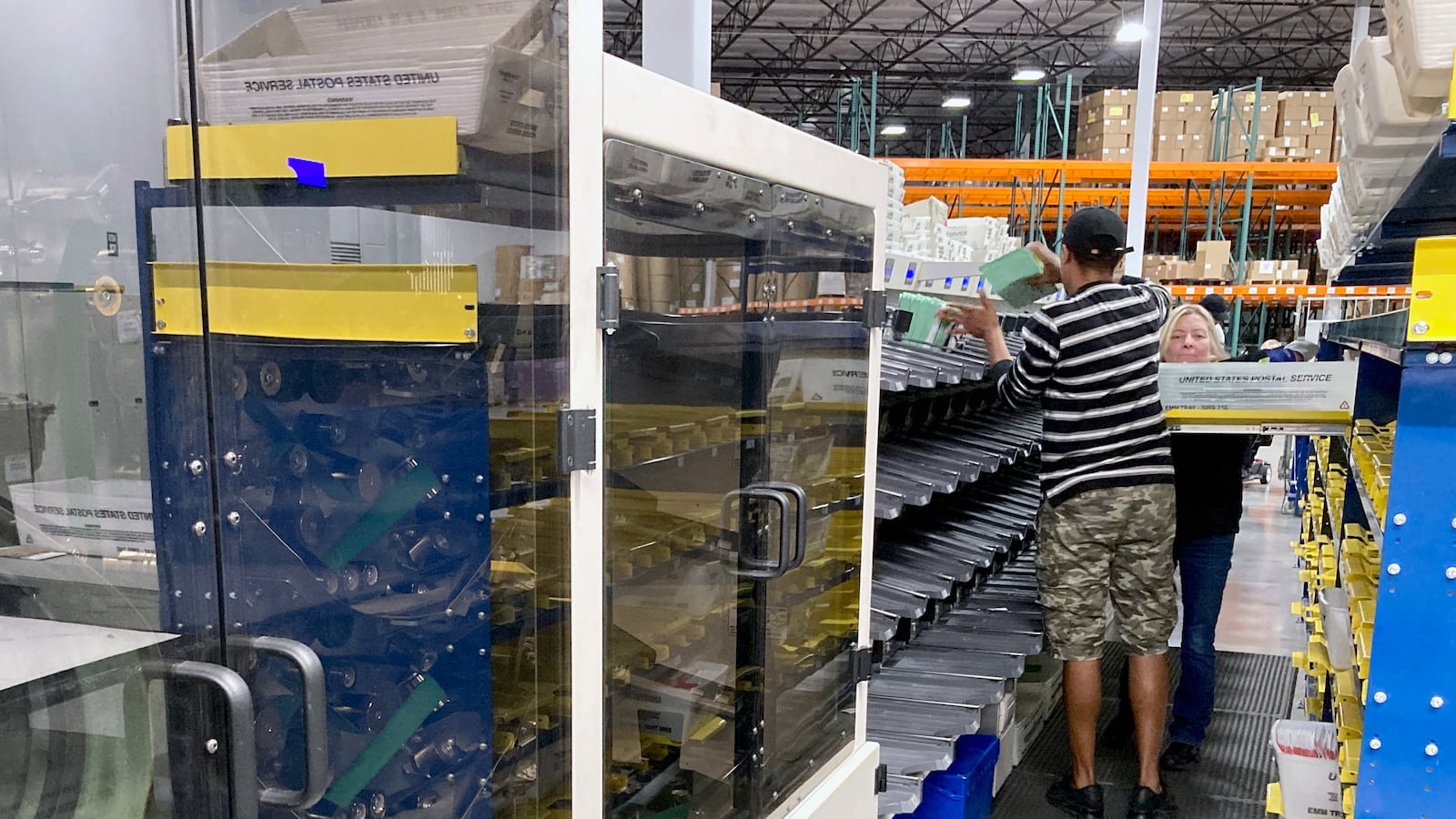The “bing bong, bing bong” of the security gate bell rings over the loudspeakers at Runbeck Election Services. Polls in Arizona’s presidential preference election closed three and a half hours ago, and ballots have finally arrived here.
The loading dock door flies up, letting in cool spring air, and workers roll in two locked cages carrying trays of green envelopes. Soon, the envelopes, with ballots still sealed inside, are shooting through Runbeck’s scanner at a rate of 12 per second. Within minutes, the voter signatures on thousands of envelopes have been scanned.
It’s fast for a reason. At times, all of America is waiting to find out the results from these ballots, which are cast in the largest swing county in the nation.
Dropped off at polling places or in ballot drop boxes on Election Day, these ballots are among the last in Maricopa County to be counted, because the voter signatures on the outer envelopes still need to be verified. It often takes days to count the votes inside, with the outcome of an election hinging on the result.
In 2020, these ballots were enough to flip the county recorder race for Stephen Richer, more than a week after the election. In 2022, these were the ballots candidate Katie Hobbs waited to be counted for days before she declared victory in the governor’s race. And this year, these are votes that could help determine who wins Arizona, and the presidency.
With the volume of these Election Day drop-offs now in the hundreds of thousands, Maricopa County turns to Runbeck, a ballot printing and processing company, out of necessity. If not for the high-speed machines Runbeck owns, it would take the county days, working nonstop, just to do the initial scan of the ballot envelopes. Even after Runbeck is done scanning the envelopes, the actual votes on the ballots still have to be counted. That’s done later, back at the county’s election headquarters.
With all eyes on Arizona for both election results and election integrity, there’s growing scrutiny of who handles these last-minute drop-offs, how they are tracked, and how fast they are counted. Complaints about the speed of counting and about ballot tracking have spurred the county and Runbeck to make changes that voters may notice in the upcoming election.

To try to speed up counting this year, Maricopa County has spent millions renovating its space to make room for more counting machines and people. Runbeck and the county are working together on other changes to count faster and allow more political party observation. The changes, according to the county’s director of Election Day voting, Scott Jarrett, are part of the election department’s drive for continuous improvement.
But larger questions remain.
Watching the ballot envelopes zip through Runbeck’s machine as a GOP observer in the March 19 presidential preference election, Don Hiatt wondered: Why is this being outsourced to a private company? Why doesn’t the county own this machine?
The county has been quietly considering this question as well. For now, it just doesn’t have the space to do the work in house, according to Jarrett and Rey Valenzuela, the county’s director of early voting. And even if it had the space, Valenzuela said, it would take time for county employees to staff up and gain the skills that Runbeck has.
But that may change. In October, county supervisors entered into a $9.8 million contract to design an entirely new election center down the street from the current one. If they approve the design this summer, the county would spend more than $85 million to build the new center in time for the 2028 presidential election.
It would allow the fast-growing county to comfortably count the more than 2 million ballots it now receives each presidential election cycle, fit the hundreds of temporary election workers it hires during these elections, and store the equipment it requires.
Jarrett and Valenzuela said in a joint phone interview that the new building might also have enough space for the county to take over the ballot envelope scanning work Runbeck currently does.
To address concerns about speed, county expands staff
The speed of ballot counting is a politically charged issue, especially in swing states like Arizona. Concerns that began in earnest in 2020 over how long it took Maricopa County to finish counting the presidential election results grew dramatically in 2022, as Hobbs and GOP opponent Kari Lake awaited their results. Lake’s claim that the county was intentionally slow-rolling the results to perpetrate election fraud attracted national attention.
The fact is, many large voting jurisdictions take a week or more to tabulate mail ballots, but depending on the volume of those ballots and the overall margins in the race, that wait doesn’t raise many concerns, because the outcome of the race doesn’t hinge on those votes.
In swing states like Arizona, these lingering, last-to-be-counted ballots command much greater attention. Statewide races here have become tighter in recent elections, and the number of voters waiting until Election Day to drop off their ballots has grown, leaving a larger percentage of the state’s results outstanding on election night. By 2022, nearly 1 in 5 voters cast their ballot this way. That’s about 290,000 ballot envelopes to scan, voter signatures to verify, envelopes to open and ballots to count.
Lake’s allegations drew more attention to the long wait in 2022. But Maricopa County was actually counting just about as fast as it typically does. County officials posted final results 13 days after the 2022 election, roughly in line with the average of 12.5 days in statewide elections since 2006. The counting timeline has not increased even as the number of votes cast has doubled.
Still, county officials started looking at how to further speed up the process. The county has spent millions since 2022 tearing down walls in its counting room and other spaces within its election center. It’s also set up trailers as temporary buildings for use during elections.
The space can now fit considerably more people to work in the areas where there were “bottlenecks,” Jarrett said. In the upcoming election, the number of workstations available for verifying voter signatures on mail ballots will be 45, nearly double the 25 stations available in 2022. There will be 75 work stations for processing boards — the two-member bipartisan teams who open ballot envelopes to prepare ballots for counting — up from 55 in 2022. And there will be twice as many bipartisan teams reviewing voter selections on ballots where machines can’t determine the voter’s intent.
The county doubled the number of high-speed ballot-counting machines at its central counting location, too, meaning that it can tabulate votes twice as fast.
On Runbeck’s end, it plans to have enough staff on election night to run two or even three of its high-speed scanning machines at once.
Even with these changes, Jarrett and Valenzuela are hesitant to make promises about how much faster, if at all, counting may go this year.
It all depends on how many people wait until Election Day to vote. And Jarrett is estimating Election Day mail ballot drop-offs will increase from about 290,000 in 2022 to 350,000 in 2024.
To address concerns about transparency, Runbeck makes changes
In Arizona, polls close at 7 p.m. Typically, it’s 9 p.m. or later when the first shipment of Maricopa County’s Election Day drop-offs make it to Runbeck.
Before that, poll workers need to pack the ballots up at 200 or more voting locations, and county workers need to pick them up from drop boxes and bring them to the county’s central counting facility. Under camera surveillance and with bipartisan observers, workers arrange the envelopes face-forward in trays. Then the trays are packed in cages with locks and rolled onto trucks waiting outside the warehouse.
As all that happens, it’s mostly quiet in the Runbeck warehouse, located down a winding road in an industrial area near Phoenix’s Sky Harbor International Airport.
Runbeck, one of the largest ballot printers in the nation, will print ballots here for 49 counties across the country in 2024, and ship more than 13 million ballots directly to voters. But on election night, only Maricopa County’s cast ballots will come through here.
The night of the presidential preference election, Runbeck workers eat pizza in the breakroom and watch a movie as they wait for the envelopes to arrive.
On a whiteboard on the wall near the envelope scanning machine, employees have written down guesses of how many ballot envelopes there will be for them. The guesses can range widely, and no one has ever gotten it exactly right, said senior vice president of operations Bryan Dandurand. Tonight, one guess is 10,000. Another is 48,729.
When the ballots do arrive, the warehouse starts buzzing. Observers from each party follow the caged ballots from the truck loading zone to the envelope scanners, each 80 feet long and 6 feet high. Security guards, from Runbeck and Maricopa County, watch over the envelopes at every step. Multiple workers confirm ballot transfer numbers at multiple steps.
Once the signatures and barcodes on about 10,000 ballot envelopes are scanned, Runbeck sends the county a file with the photos. County workers then use those photos to start comparing voter signatures with registration records. If workers end up challenging a signature, Runbeck uses the machines to separate those envelopes into separate trays before they are returned to the county.
In all, about 30,000 envelopes come through the warehouse on the night of the presidential preference election, right in the middle of the range of guesses on the whiteboard.
Maricopa County picks up the ballots from Runbeck after they are scanned, opens the envelopes and counts the votes inside once they are back at its central counting facility.

Seeing all of these security protocols in place at Runbeck in person for the first time, Democratic Party observer Ed Giebel said he was even more confident in the process, and even more disturbed by the “wild claims” he has heard about widespread voting fraud.
“It’s not like you can inject 5,000 ballots into the process,” Giebel said.
Yet, that’s effectively what Lake alleged in 2022. And while there has been no physical evidence to support that claim, the allegation has forced Runbeck and the county to take even more steps to increase transparency.
In 2022, Lake’s legal team noticed that on ballot-tracking documents, the county had recorded an incorrect estimate of Election Day mail ballot drop-offs before the ballots were shipped to Runbeck.
The county hadn’t counted the exact number of these ballots before shipping them to Runbeck, and historically never has. Instead, it has estimated the number of ballots it was sending to the warehouse based on the number of trays they packed.
But Lake said in court that the incorrect estimate was proof that there were tens of thousands of ballots illegally inserted at this facility. Also, a witness told the judge that Runbeck employees had been casting ballots on site.
Courts repeatedly rejected Lake’s claims for lack of evidence, and her attorneys were eventually sanctioned for falsely claiming that it was an “undisputed” fact that 35,563 ballots were injected to the results at Runbeck.
Jeff Ellington, CEO of Runbeck, has since told Votebeat these claims have led to harassment and threats against him. But Dandurand said that their employees have been mostly isolated from all this.
He talks in great length about the efforts that Runbeck takes to hire employees who call out errors when they see them and understand the importance of integrity when processing ballot envelopes.
Yet, the pressure to tighten processes hasn’t let up.
After the 2022 election, State Rep. Alex Kolodin and state Sen. Wendy Rogers, both Republicans, led an investigative committee in the legislature that pushed Runbeck to provide greater transparency into its process. Earlier this year, Runbeck signed an agreement with state lawmakers to provide for more transparency in ballot tracking and political party observer rules.
The ballot tracking forms now make clear when numbers are estimates, and when they are exact machine counts. There will be more political party observers allowed, and these observers will have access to a room where they can watch TV screens that show all ballot activity in the building live. And Runbeck will no longer allow employees to cast their own ballots on site, Dandurand said.
Also, under a new law, poll workers will try to get an exact count of the number of these ballots on site at their location, before they are transferred to the county for sorting, then to Runbeck for scanning. Kolodin pushed for this new rule hoping it would avoid the incorrect county estimates, but election officials worry that any inaccuracies will lead to more fraud claims.
Kolodin said that after his investigation, he is “a lot less concerned about Runbeck” than he was before, and he is glad Runbeck agreed on new transparency measures.
“Eyes on the process is always the best way to avoid problems,” he said.
Still, Kolodin said many of his constituents are concerned that the ballots they cast go through Runbeck afterward. He sees a few good arguments for doing the work in house.
Involving Runbeck in the chain of custody creates more opportunities for errors or bad actors, he said. He is also concerned that private contractors can more easily push back against public records laws.
Indeed, in 2022, a judge denied a public-records request from an advocacy organization allied with Lake to force Runbeck to turn over security video footage. Runbeck has since agreed to let lawmakers review its video.
Kolodin said if the county did the ballot scanning work instead, there would be “better legal teeth for oversight for ordinary members of the public.”
Why moving scanning in house would be a challenge
As concerns about Runbeck circulated in the public this summer, Jarrett said elections staff studied if Maricopa County could take on the work of scanning the ballot envelopes. Right now, Maricopa County pays Runbeck 98 cents per ballot for its scanning services.
The high-speed machines cost about $1 million each, according to Runbeck, and the county would need a few. The county would also need staff and money on hand for machine maintenance, and skilled staff to operate the machines.
The county has always been planning to continue to expand its election space, even after the renovations it just finished. This summer, around the time it was evaluating if it could replace Runbeck for ballot scanning, it decided it should build an entirely new building in order to accommodate all its future needs.
The new building, if approved, would double the amount of space the county has available for elections, and allow the recorder’s office early-voting team to move in.
Each day, more than 150 people move to Maricopa County, making it one of the nation’s fastest-growing counties and pushing its rolls of registered voters toward 2.4 million. About 79% of voters are on the early-voting list to receive mail ballots, up from 40% in 2016.
Only a few places in the country see as many mail ballots. But some California jurisdictions compare, including Los Angeles and Orange counties.
In 2007, Orange County’s then-registrar of voters, Neal Kelley, decided to take the county’s entire ballot printing and scanning process in-house after growing frustrated with mistakes the county’s ballot printer was making. He purchased the same high-speed scanners that Runbeck uses to scan envelopes.
He said taking it all in-house allowed the county to gain more control over timing. But it came with challenges. He ended up needing to staff a machine maintenance manager year-round, and his elections center “became a parts warehouse” as he tried to keep the machines in working order.
Los Angeles County, which is larger than Maricopa County with 5 million registered voters, owns six or seven high-speed envelope scanners, said spokesperson Mike Sanchez. It takes between 12 to 20 people to staff those machines, most of them seasonal, temporary employees, with permanent staff supervising.
But in California, there isn’t the same pressure to count the wave of Election Day ballots quickly. State law allows voters to put their ballots in the mail right up until Election Day and still have them be counted when the counties receive them. Counting runs for weeks after the election, Sanchez said.

In Maricopa County, the new facility being designed would help ease some bottlenecks in the ballot-handling process, but county spokesperson Fields Moseley said he wouldn’t want to promise faster counting because of it.
Taking Runbeck’s scanning work in-house wouldn’t necessarily make ballot processing faster either, Jarrett and Valenzuela said. It would just put everything under one roof, making the process more efficient and transparent. It might cut out the 15 minute trips the ballots make back and forth to Runbeck, they said, but the process still has to start with sorting and scanning the envelopes, no matter where it happens.
Finding skilled staff is another challenge, a point emphasized by both Kelley in Orange County and Dandurand at Runbeck. Few workers have experience handling ballots, they said, which requires more integrity than working in other mail or printing businesses.
Maricopa County already struggles to find enough temporary workers during busy election cycles, and taking this work in-house would mean finding more each year, and more willing to work odd hours.
At Runbeck, workers take their “lunch break” at midnight, when work on machines pauses for a required daily reboot.
These workers won’t be done with their shift until just before the sun comes up.
Jen Fifield is a reporter for Votebeat based in Arizona. Contact Jen at jfifield@votebeat.org.

